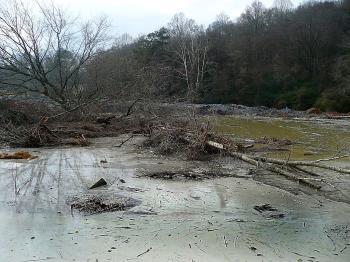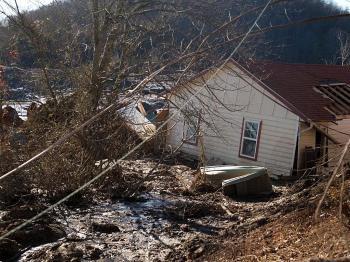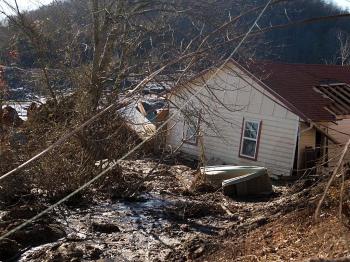Coal ash is in a tug of war between environmentalists and the coal industry over its impending regulation—whether or not it is hazardous. It is currently unregulated and the industry is lobbying hard to keep it that way.
Every year the United States produces about 70 million tons of fly ash (coal ash) from coal-fired power plants, according to the American Coal Ash Association (ACAA). Environmentalists say the mercury, arsenic, and other toxins should be classified as hazardous.
Every year the United States produces about 70 million tons of fly ash (coal ash) from coal-fired power plants, according to the American Coal Ash Association (ACAA). Environmentalists say the mercury, arsenic, and other toxins should be classified as hazardous.
The debate was revived in December 2008 when a 1 billion-gallon spill of coal ash sludge poured down a hillside in Kingston, Tennessee.
The spill covered 300 acres, destroyed homes, poisoned rivers, and contaminated coves and residential drinking waters, according to an article the Earth Justice Web site. The Web site said one of the victims of the spill, Bridget Daugherty, was leaving her home along the Emory River when she noticed the roof to her neighbor’s deck had crashed to the ground. Her surprise turned to horror as she saw what brought it down—an oozing gray muck 20 feet deep in places.
“I went on to work and called my husband,” she told Earth Justice. “He came home and called me and said, ‘You’re not going to believe this. It’s astronomical.’”
The coal ash had spilled from the Tennessee Valley Authority’s Kingston Fossil Plant.
One year later, the area is economically and environmentally dead, says Jeff Ruch, executive director of Public Employees for Environmental Responsibility (PEER), an environmental advocacy group. “My impression is that it’s a wasteland.”
“Generally nobody recommends it [coal ash] comes into contact with human beings,” said Mr. Ruch.
Meanwhile, the coal industry is hailing the use of coal ash as one of the greatest recycling success stories. It is used for making concrete, carpet backing, and wall board for construction.
The ACAA has partnered with other coal industries and the U.S. Environmental Protection Agency (EPA) to promote the use of recycling the coal ash—creating an organization called the Coal Combustion Products Partnership (C2P2).
The partnership is a direct conflict of interest, says Ruch. He said it will be difficult for the EPA to make an unbiased decision while being wed to the coal industry—an $11 billion to $13 billion industry.
The EPA is expected to make a regulatory decision in the coming weeks on whether coal ash and other coal combustion byproducts are hazardous or not—affecting the disposal of the material.
Currently, around 45 percent of fly ash is recycled, and the ACAA aims to boost the use of byproducts in concrete by 50 percent, to 18.6 million tons in 2011.
Ruch says there is scientific consensus that coal ash is “pretty toxic” and PEER is pushing for the dissolution of the C2P2 partnership. PEER has obtained thousands of e-mails between the coal industry and the EPA and is releasing them onto their Web site over the next few weeks.
The e-mails released so far show how the C2P2 partnership gave the coal ash industry a chance to change a variety of EPA draft publications and presentations, including the removal of “cautionary language” about application of coal combustion wastes on agricultural lands in an EPA brochure.
EPA fact-sheets and PowerPoint presentations were altered at industry urging to delete significant references to certain potential “high risk” uses of coal combustion wastes, a PEER press release stated.
A coal ash industry representative joked to EPA staff in an Oct. 27, 2008, e-mail, referring to a news article about mercury contamination from coal ash:
“We are in bed with the EPA again, it looks, at least according to this article. The advocacy groups are well organized and have the ready ear of the press.”
Adora Andy, a spokeswoman for EPA Administrator Lisa Jackson, issued a statement in response to a recent PEER report, saying the EPA is considering whether the C2P2 partnership should be continued.
“The American people deserve to know their EPA is protecting them and their children, not the interests of industry lobbyists,” she said in the statement.
Ruch says the EPA has not done adequate scientific homework on the recycled use of coal ash. Tests for toxic leaching in concrete that gets broken apart, or carpet that gets flooded, has not been done, he said.
The waste product is more toxic than it used to be, as air pollution controls have become more stringent, the EPA said in 2000. At least the wet storage of coal ash, such as in Tennessee, needs to be labeled hazardous and regulated, Ruch said.
This is what the coal industry is railing against, he said. Classifying the wet storage of coal ash as hazardous would create a stigma that the use of the same product in concrete and other products is also hazardous—rattling the billion dollar industry.
Ruch says the decision EPA is now facing will be the toughest environmental decision for the Obama administration, as the Clean Energy Program is rooted in coal use.
“I went on to work and called my husband,” she told Earth Justice. “He came home and called me and said, ‘You’re not going to believe this. It’s astronomical.’”
The coal ash had spilled from the Tennessee Valley Authority’s Kingston Fossil Plant.
One year later, the area is economically and environmentally dead, says Jeff Ruch, executive director of Public Employees for Environmental Responsibility (PEER), an environmental advocacy group. “My impression is that it’s a wasteland.”
“Generally nobody recommends it [coal ash] comes into contact with human beings,” said Mr. Ruch.
Meanwhile, the coal industry is hailing the use of coal ash as one of the greatest recycling success stories. It is used for making concrete, carpet backing, and wall board for construction.
The ACAA has partnered with other coal industries and the U.S. Environmental Protection Agency (EPA) to promote the use of recycling the coal ash—creating an organization called the Coal Combustion Products Partnership (C2P2).
The partnership is a direct conflict of interest, says Ruch. He said it will be difficult for the EPA to make an unbiased decision while being wed to the coal industry—an $11 billion to $13 billion industry.
Impending Decisions
The EPA is expected to make a regulatory decision in the coming weeks on whether coal ash and other coal combustion byproducts are hazardous or not—affecting the disposal of the material.
Currently, around 45 percent of fly ash is recycled, and the ACAA aims to boost the use of byproducts in concrete by 50 percent, to 18.6 million tons in 2011.
Ruch says there is scientific consensus that coal ash is “pretty toxic” and PEER is pushing for the dissolution of the C2P2 partnership. PEER has obtained thousands of e-mails between the coal industry and the EPA and is releasing them onto their Web site over the next few weeks.
The e-mails released so far show how the C2P2 partnership gave the coal ash industry a chance to change a variety of EPA draft publications and presentations, including the removal of “cautionary language” about application of coal combustion wastes on agricultural lands in an EPA brochure.
EPA fact-sheets and PowerPoint presentations were altered at industry urging to delete significant references to certain potential “high risk” uses of coal combustion wastes, a PEER press release stated.
A coal ash industry representative joked to EPA staff in an Oct. 27, 2008, e-mail, referring to a news article about mercury contamination from coal ash:
“We are in bed with the EPA again, it looks, at least according to this article. The advocacy groups are well organized and have the ready ear of the press.”
Adora Andy, a spokeswoman for EPA Administrator Lisa Jackson, issued a statement in response to a recent PEER report, saying the EPA is considering whether the C2P2 partnership should be continued.
“The American people deserve to know their EPA is protecting them and their children, not the interests of industry lobbyists,” she said in the statement.
Ruch says the EPA has not done adequate scientific homework on the recycled use of coal ash. Tests for toxic leaching in concrete that gets broken apart, or carpet that gets flooded, has not been done, he said.
The waste product is more toxic than it used to be, as air pollution controls have become more stringent, the EPA said in 2000. At least the wet storage of coal ash, such as in Tennessee, needs to be labeled hazardous and regulated, Ruch said.
This is what the coal industry is railing against, he said. Classifying the wet storage of coal ash as hazardous would create a stigma that the use of the same product in concrete and other products is also hazardous—rattling the billion dollar industry.
Ruch says the decision EPA is now facing will be the toughest environmental decision for the Obama administration, as the Clean Energy Program is rooted in coal use.











Friends Read Free